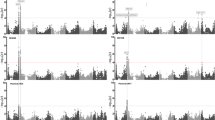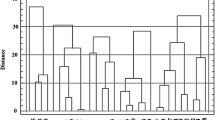Abstract
This study maps genomic regions associated with terminal heat- and drought-stress tolerance in barley (Hordeum vulgare L.). One hundred lines were randomly sampled from a ND24260 × Flagship doubled haploid population and evaluated for stay-green (SG) expression. SG expression including that of parental controls and commercial check varieties was evaluated in two controlled environments; one simulating terminal heat-stress, the other terminal water-stress. During grain-fill the greenness of the spikes (S), flag leaf (FL) and the first leaf under the flag leaf (FL-1) were phenotyped; visually (using a 0–9 scale) and via single-photon avalanche diode measurements. From the visual assessments, the green leaf area of the plant was determined, by using the difference in green area of the S and FL. Composite interval mapping detected 10 quantitative trait loci (QTL) for SG, positioned on chromosomes 3H, 4H, 5H, 6H and 7H; six of which were associated with terminal heat-stress and four with terminal water-stress. None were co-located with previously reported barley stress-response QTL and thus represent novel barley QTL. Although novel, some SG QTL mapped near chromosomal regions previously reported; such as the two heat-stress QTL mapped to bPb-5529 on 5H, adjacent to QTL reported for root length and root-shoot ratio. Detection of SG QTL in barley grown under simulated heat- and water-stressed conditions offers the potential of high through put screening for these traits. If confirmed in field trials, these genomic regions will be candidates for barley breeding programs targeting improved abiotic stress tolerance via marker-assisted selection.



Similar content being viewed by others
Abbreviations
- SG:
-
Stay-green
- MAS:
-
Marker-assisted selection
- GS:
-
Green spike
- GFL:
-
Green flag leaf
- GFL-1:
-
Green first leaf under the flag leaf
- LAUG:
-
Leaf area under green
- SP:
-
SPAD (Single-photon avalanche diode)
- DH:
-
Double haploid
- CIM:
-
Composite interval mapping
- DArT:
-
Diversity Array Technology
- LOD:
-
Logarithm of odds
References
Arifuzzaman M, Sayed MA, Muzammil S, Pillen K (2014) Detection and validation of novel QTL for shoot and root traits in barley (Hordeum vulgare L.). Mol Breed 34(3):1373–1387. doi:10.1007/s11032-014-0122-3
Arriola KG, Kim SC, Huisden CM, Adesogan AT (2012) Stay-green ranking and maturity of corn hybrids: 1. Effects on dry matter yield, nutritional value, fermentation characteristics, and aerobic stability of silage hybrids in Florida. J Dairy Sci 95(2):964–974. doi:10.3168/jds.2011-4524
Ashraf M (2010) Inducing drought tolerance in plants: recent advances. Biotechnol Adv 28(1):169–183. doi:10.1016/j.biotechadv.2009.11.005
Borrell AK, Mullet JE, George-Jaeggli B, Oosterom EJ, Hammer GL, Klein PE, Jordan DR (2010) Drought adaptation of stay-green sorghum is associated with canopy development, leaf anatomy, root growth, and water uptake. J Exp Bot 28:1–13. doi:10.1093/jxb/eru232
Cakir M, Poulsen D, Galwey NW, Ablett GA, Chalmers KJ, Platz GJ, Park RF, Lance RCM, Panozzo JF, Read BJ, Moddy DB, Barr AR, Johnston P, Li CD, Boyd WJR, Grime CR, Appels R, Jones MGK, Langridge P (2003) Mapping and QTL analysis of the barley population Tallon × Kaputar. Aust J Agric Res 54(12):1155–1162. doi:10.1071/AR02238
Cattivelli L, Rizza F, Badeck FW, Mazzucotelli E, Mastrangelo AM, Francia E, Marè C (2008) Drought tolerance improvement in crop plants: an integrated view from breeding to genomics. Field Crop Res 105(1–2):1–14. doi:10.1016/j.fcr.2007.07.004
Chen GX, Krugman T, Fahima T, Chen KG, Hu Y, Röder M, Nevo E, Korol A (2010) Chromosomal regions controlling seedling drought resistance in Israeli wild barley, Hordeum spontaneum C Koch. Genet Resourc Crop Evol 57(1):85–99. doi:10.1007/s10722-009-9453-z
Christopher JT, Manschadi AM, Hammer GL, Borrell AK (2008) Developmental and physiological traits associated with high yield and stay-green phenotype in wheat. Aust J Agric Res 59(4):354–364. doi:10.1071/AR07193
Collard BCY, Jahufer MZZ, Brouwer JB, Pang ECK (2005) An introduction to markers, quantitative trait loci (QTL) mapping and marker-assisted selection for crop improvement: the basic concepts. Euphytica 142(1–2):169–196. doi:10.1007/s10681-005-1681-5
Collard BCY, Mackill DJ (2008) Marker-assisted selection: an approach for precision plant breeding in the twenty-first century. Phil Trans R Soc B 363(1491):557–572. doi:10.1098/rstb.2007.2170
Coombes NE (2002) The reactive tabu search for efficient correlated experimental designs. Liverpool John Moores University, Liverpool
Crasta OR, Xu WW, Rosenow DT, Mullet J, Nguyen HT (1999) Mapping of post-flowering drought resistance traits in grain sorghum: association between QTLs influencing premature senescence and maturity. Mol Gen Genet 262(3):579–588. doi:10.1007/s004380051120
Dailey JE, Peterson DE, Osborn TC (1988) Hordein gene expression in a low protein barley cultivar. Plant Physiol 88(2):450–453. doi:10.1104/pp.88.2.450
Demey JR, Vicente-Villardón JL, Galindo-Villardón MP, Zambrano AY (2008) Identifying molecular markers associated with classification of genotypes by External Logistic Biplots. Bioinformatics 24(24):2832–2838. doi:10.1093/bioinformatics/btn552
Diab AA, Teulat-Merah B, This D, Ozturk NZ, Benscher D, Sorrells ME (2004) Identification of drought-inducible genes and differentially expressed sequence tags in barley. Theor Appl Genet 109(7):1417–1425. doi:10.1007/s00122-004-1755-0
Eglinton J (2006) Flagship barley (Hordeum vulgare). Plant Breeders Rights. http://pericles.ipaustralia.gov.au/pbr_db/plant_detail.cfm?AID=10505989
Fox GP, Panozzo JF, Li CD, Lance RCM, Inkerman PA, Henry RJ (2003) Molecular basis of barley quality. Austr J Agric Res 54(12):1081–1101. doi:10.1071/AR02237
Franckowiak JD, Horsley RD, Neate SM, Schwarz PB (2007) Registration of ‘Rawson’ barley. J Plant Regist 1:37–38. doi:10.3198/jpr2006.10.0664crc
Gabriel KR (1971) The biplot graphical display of matrices with application to principal components analysis. Biometrika 58(3):453–467. doi:10.1093/biomet/58.3.453
Gous PW, Hasjim J, Franckowiak J, Fox GP, Gilbert RG (2013) Barley genotype expressing “stay-green”-like characteristics maintains starch quality of the grain during water stress condition. J Cereal Sci 1(6):414–419. doi:10.1016/j.jcs.2013.08.002
Gous PW, Lawson W, Kelly A, Martin A, Fox GP, Sutherland M (2012) QTL associated with barley (Hordeum vulgare) feed quality traits measured through in situ digestion. Euphytica 185(1):37–45. doi:10.1007/s10681-011-0608-6
Gregersen PL, Gregersen PL, Holm PB, Krupinska K (2008) Leaf senescence and nutrient remobilisation in barley and wheat. Plant Biol (Stuttg) 10:37. doi:10.1111/j.1438-8677.2008.00114.x
Guo P, Baum M, Varshney RK, GraneR A, Grando S, Ceccarelli S (2008) QTLs for chlorophyll and chlorophyll fluorescence parameters in barley under post-flowering drought. Euphytica 163(2):203–214. doi:10.1007/s10681-007-9629-6
Hamblin J, Stefanova K, Angessa TT (2014) Variation in Chlorophyll Content per Unit Leaf Area in Spring Wheat and Implications for Selection in Segregating Material. PLoS ONE 9(3):e92529. doi:10.1371/journal.pone.0092529
Harris K, Subudhi PK, Borrell A, Jordan D, Rosenow D, Nguyen H, Klein P, Klein R, Mullet J (2007) Sorghum stay-green QTL individually reduce post-flowering drought-induced leaf senescence. J Exp Bot 58(2):327–338. doi:10.1093/jxb/erl225
Hickey LT, Lawson W, Platz GJ, Dieters M, Arief VN, German S, Fletcher S, Park RF, Singh D, Pereyra S, Franckowiak J (2011a) Mapping Rph20: a gene conferring adult plant resistance to Puccinia hordei in barley. Theor Appl Genet 123(1):55–68. doi:10.1007/s00122-011-1566-z
Hickey LT, Lawson W, Platz GJ, Dieters M, Arief VN, Germán S, Fletcher S, Park RF, Singh D, Pereyra S, Franckowiak J (2011b) Mapping Rph20: a gene conferring adult plant resistance to Puccinia hordei in barley. Theor Appl Genet 123(1):55–68. doi:10.1007/s00122-011-1566-z
Hickey LT, Lawson W, Arief VN, Fox G, Franckowiak J, Dieters MJ (2012) Grain dormancy QTL identified in a doubled haploid barley population derived from two non-dormant parents. Euphytica 188:113–122. doi:10.1007/s10681-011-0577-9
Jordan DR, Hunt CH, Cruickshank AW, Borrell AK, Henzell RG (2012) The relationship between the stay-green trait and grain yield in elite sorghum hybrids grown in a range of environments. Crop Sci 52(3):1153–1161. doi:10.2135/cropsci2011.06.0326
Joshi AK, Kumari M, Singh VP, Reddy CM, Kumar S, Rane J, Chand R (2007) Stay green trait: variation, inheritance and its association with spot blotch resistance in spring wheat (Triticum aestivum L.). Euphytica 153(1–2):59–71. doi:10.1007/s10681-006-9235-z
Li JH, Vasanthan T, Rossnagel B, Hoover R (2001) Starch from hull-less barley: I. Granule morphology, composition and amylopectin structure. Food Chem 74(4):395–405
Ling Q, Huang W, Jarvis P (2011) Use of a SPAD-502 meter to measure leaf chlorophyll concentration in Arabidopsis thaliana. Photosynth Res 107(2):209–214. doi:10.1007/s11120-010-9606-0
Mace E, Rami J, Bouchet S, Klein P, Klein R, Kilian A, Wenzl P, Xia L, Halloran K, Jordan D (2009) A consensus genetic map of sorghum that integrates multiple component maps and high-throughput Diversity Array Technology (DArT) markers. BMC Plant Biol 9(1):13
Netto AL, Campostrini E, Goncalves de Oliveira J, Bressan-Smith RE (2004) Photosynthetic pigments, nitrogen, chlorophyll α fluorescence and SPAD-502 readings in coffee leaves. Sci Hortic-Amsterdam 104(2005):199–209. doi:10.1016/j.scienta.2004.08.013
Phuong N, Afolayan G, El Soda M, Stützel H, Wenzel W, Uptmoor R (2014) Genetic dissection of pre-flowering growth and development in sorghum bicolor l. moench under well-watered and drought stress conditions. Agric Sci 5(11):923–934. doi:10.4236/as.2014.511100
Rollins JA, Drosse B, Mulki MA, Grando S, Baum M, Singh M, Ceccarelli S, Mv Korff (2013) Variation at the vernalisation genes Vrn H1 and Vrn H2 determines growth and yield stability in barley (Hordeum vulgare) grown under dryland conditions in Syria. Theor Appl Genet 126(11):2803–2824. doi:10.1007/s00122-013-2173-y
Rong-hua L, Pei-guo G, Baum M, Grando S, Ceccarelli S (2006) Evaluation of chlorophyll content and fluorescence parameters as indicators of drought tolerance in Barley. Agric Sci China 5(10):751–757. doi:10.1016/S1671-2927(06)60120-X
Rong H, Tang Y, Zhang H, Wua P, Chen Y, Li M, Wua G, Jiang H (2013) The Stay-Green Rice like (SGRL) gene regulates chlorophyll degradation in rice. J Plant Physiol 170(15):1367–1373. doi:10.1016/j.jplph.2013.05.016
Siahsar BA, Narouei M (2010) Mapping QTLs of physiological traits associated with salt tolerance in ‘Steptoe’x’Morex’ doubled haploid lines of barley at seedling stage. J Food Agric Environ 8:751–759
Spano G, Fonzo ND, Perrotta C, Platani C, Ronga G, Lawlor DW, Napier JA, Shewry PR (2003) Physiological characterization of `stay green’ mutants in durum wheat. J Exp Bot 54(386):1415–1420. doi:10.1093/jxb/erg150
Tao YZ, Henzell RG, Jordan DR, Butler DG, Kelly AM, McIntyre CL (1999) Identification of genomic regions associated with stay green in sorghum by testing RILs in multiple environments. Theor Appl Genet 100(8):1225–1232. doi:10.1007/s001220051428
Teulat B, Borries C, This D (2001) New QTLs identified for plant water status, water-soluble carbohydrate and osmotic adjustment in a barley population grown in a growth-chamber under two water regimes. Theor Appl Genet 103(1):161–170. doi:10.1007/s001220000503
Thomas H, Howarth CJ (2000) Five ways to stay green. J Exp Bot 51(suppl 1):329–337. doi:10.1093/jexbot/51.suppl_1.329
Vaezi B, Bavei V, Shiran B (2010) Screening of barley genotypes for drought tolerance by agro-physiological traits in field condition. Afr J Agric Res 5(9):881–892. doi:10.5897/AJAR09.294
Voorrips RE (2002) MapChart: software for the graphical presentation of linkage maps and QTLs. J Hered 93(1):77–78. doi:10.1093/jhered/93.1.77
Wang S, Basten CJ, Zeng ZB (2002) Windows QTL Cartographer: WinQtlCart V2.0
Wenzl P, Li H, Carling J, Zhou M, Raman H, Paul E, Hearnden P, Maier C, Xia L, Caig V, Ovesná J, Cakir M, Poulsen D, Wang J, Raman R, Smith KP, Muehlbauer GJ, Chalmers KJ, Kleinhofs A, Huttner E, Kilian A (2006) A high-density consensus map of barley linking DArT markers to SSR, RFLP and STS loci and agricultural traits. BMC Genom 7(206):1–22. doi:10.1186/1471-2164-7-206
Xue D-W, Chen M-C, Zhou M-X, Chen S, Mao Y, Zhang G-P (2008) QTL analysis of flag leaf in barley (Hordeum vulgare L.) for morphological traits and chlorophyll content. J Zhejiang Univ Sci B 9(12):938–943. doi:10.1631/jzus.B0820105
Yang J, Hu C, Hu H, Yu R, Xia Z, Ye X, Zhu J (2008) QTLNetwork: mapping and visualizing genetic architecture of complex traits in experimental populations. Bioinformatics 24(5):721–723. doi:10.1093/bioinformatics/btm494
Yang J, Zhu J, Williams RW (2007) Mapping the genetic architecture of complex traits in experimental populations. Bioinformatics 23(12):1527–1537. doi:10.1093/bioinformatics/btm143
Zadoks JC, Chang TT, Konzak CF (1974) A decimal code for the growth stages of cereals. Weed Res 14(6):415–421. doi:10.1111/j.1365-3180.1974.tb01084.x
Acknowledgments
The authors thank and acknowledge the support of the 1000-Talents Program of the Chinese Government’s Foreign Experts Bureau, and the Grain Research and Development Corporation for a Ph.D. top-up scholarship.
Author information
Authors and Affiliations
Corresponding author
Rights and permissions
About this article
Cite this article
Gous, P.W., Hickey, L., Christopher, J.T. et al. Discovery of QTL for stay-green and heat-stress in barley (Hordeum vulgare) grown under simulated abiotic stress conditions. Euphytica 207, 305–317 (2016). https://doi.org/10.1007/s10681-015-1542-9
Received:
Accepted:
Published:
Issue Date:
DOI: https://doi.org/10.1007/s10681-015-1542-9




